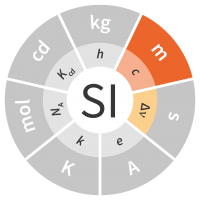Traceability is obtained directly through an experimental realization provided by a laser interferometry experiment with homodyne detection and has as base unit, the meter, symbol m, the SI length unit.Is defined by taking the fixed numerical value of the speed of light in vacuum c to be 299 792 458 when expressed in the unit m s–1, where the second is defined in terms of the caesium frequency ΔvCs
Derived Units
Derived units in this field:
Acceleration: m · s¯²
Velocity: m · s¯¹
The implementation of an experimental accelerometer absolute calibration system, using laser interferometry with homodyne detection, ensures national traceability in this field.
This method is essentially based on a sinusoidal excitation and a Michelson interferometer, allowing to determination of the acceleration value as a function of the number fringes of maximum or minimum intensity of the optical signal.
The sensitivity of a standard accelerometer is calculated by the ratio of the amplitude of the output signal from a charge amplifier (voltage signal) to the amplitude of the acceleration.
The developed method allows the determination of the value of the load sensitivity and voltage sensitivity of standard accelerometers in the range between 20 Hz and 1 kHz, with expanded uncertainty values below 1%.
In order to extend the measurement range to frequency values of up to 2 kHz, a new method is in full implementation phase, which uses the determination of the phase difference between two extremes of displacement.
Vibrations
Pioneer of vibrational conditioning applied to electronic equipment in Portugal, this laboratory has the ability to respond to the needs of the industry in response to equipment test specifications, which are not normally available due to their specificity and requirements.
The existing technical conditions allow to cover most of the requirements defined in the most usual International Standards that regulate this matter (IEC 68 and MIL-STD810), carrying out studies and determining the characteristics of equipment, being equipped with capabilities to perform simulations of adverse conditions of operation or transportation.

 The Vibrations Laboratory has the mission to materialize, maintain and disseminate the units of acceleration, as well as the development and implementation of new methods and measurement capabilities.
The Vibrations Laboratory has the mission to materialize, maintain and disseminate the units of acceleration, as well as the development and implementation of new methods and measurement capabilities.
